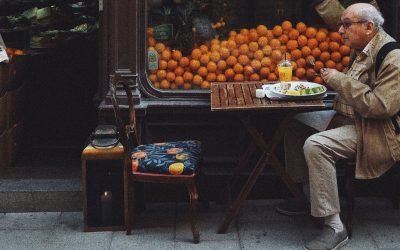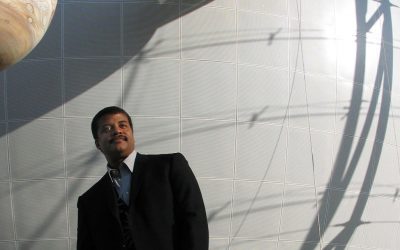ISSUE 4: TIME
Humans experience time the way a fish experiences water: It’s so pervasive, it’s impossible to step back and experience its entirety.
Which leaves a lot of questions.
Does time exist as we perceive it? What if we could go back and change the past? Is time the down-to-the-millisecond technology on our smartphones or is it something far more fluid? How does the world change when we measure time by light and shadow or the passing seasons, rather than a wristwatch?
Once we’d pinned down the theme for…
This image of Vancouver’s Sinclair Centre shows not only the time, but the passage of time: the modern lines of the skyscrapers that have sprung up to dwarf the historic clock tower, which was built in 1909, stand in stark contrast to the ornate architecture of the past. Photo by Marco Brito.
STORIES IN THIS ISSUE
4 Experiments to Increase your Productivity
If you’re like me, your work day started something like this: Sit down at computer. Check email. Check social media. Get drawn into…
When it Comes to Climate Change, the Time is Now
In August, people in Prince George, B.C. woke up to the sun blotted out from smoke—an eerie night sky at 9 a.m. that could only be described…
Women Who Dig: A Pastoral Meditation on Time
When the first roosters crow in southwestern Uganda, the world outside steeps in darkness. By the second crow, the abahingi mukazi…
How Different Cultures Understand Time
Time is seen in a particularly different light by Eastern and Western cultures, and even within these groupings assumes quite dissimilar…
Shared Histories (BOOK REVIEW)
Shared Histories: Witsuwit’en-Settler Relations in Smithers, British Columbia, 1913-1973 (Creekstone Press, 2018) by Tyler McCreary…
Alone Time: An Urban Foodie on Dining Solo (AUDIO)
As someone with small-town roots, the way time moves in a major urban city like Toronto is at a jarring, break-neck pace. Time is condensed…
Spiralling Forward: Marking Time through Ritual
I was raised to understand time as linear and, as I get older, I reflect on the years that have passed and how they uniquely contribute…
Astrophysics for People in a Hurry: Take Your Time
How much time do you need to understand the universe? Without turning the question into a thought experiment about infinity, Neil…
Why Life Speeds Up (and How to Slow Down)
Does time pass more quickly for old people? And why do they drive so slowly? I’m not old, but I older than I was. Clerks call me miss…
TIME: AS TOLD BY US
Humans experience time the way a fish experiences water: It’s so pervasive, it’s impossible to step back and experience its entirety.
Which leaves a lot of questions.
Does time exist as we perceive it? What if we could go back and change the past? Is time the down-to-the-millisecond technology on our smartphones or is it something far more fluid? How does the world change when we measure time by light and shadow or the passing seasons, rather than a wristwatch?
Once we’d pinned down the theme for this issue, we felt incredibly self-satisfied—and justifiably overwhelmed. With so many questions and so few answers, we scattered our thoughts to some esteemed writers and thinkers. And got some thoughtful responses.
In this issue, we examine time from both a pastoral perspective and a religious one. We visit it from both Eastern and Western worldviews. We look at the elasticity of time in an ever-accelerating world, what happens when you allow yourself to slow down and whether time exists at all (according to Einstein, concepts of past, present and future are an illusion.)
…according to Einstein, concepts of past, present and future are an illusion.
Sarah Duignan’s interview with Dino Tinapay explores alone time and the lost art of dining solo—something we rarely experience in a world where smartphones are an easy way to fill time. Within Chris Bailey’s unorthodox experiments on productivity, we find a similar theme: the importance of spending down time, of seeking boredom, in order to make space for sudden insights and creativity.
We view Indigenous and settler relations through time in northwestern British Columbia, as told in the book Shared Histories, reviewed here by Jane Stevenson.
We stop to appreciate the preciousness of time as a changing climate elicits doomsday warnings from scientists.
Our feature image, by Vancouver photographer Marco Brito, illustrates time as it exists in our modern world: the ageing stone clock tower dwarfed by the steel and glass of modern architecture.
Is our concept of time similarly being challenged?
In Culturally Modified’s home of northwest British Columbia, it’s autumn. It says so on the calendar. The phone reads 1:57 on a Wednesday afternoon. iCalendar adds that it’s a full moon.
But we know this by gazing out the window: the trees have all but shed their orange leaves, the golden hue to the day, the sun already beginning to sink in the sky. The moon, shining round and bright, in last night’s sky.
It’s a time of moving inward. A time of harvest. Social calendars slow. Evenings darken. Our focus changes. Not according to any human-created agenda. Simply because it’s that time.








